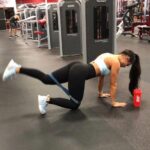What’s the best fitness routine for me? This is a question that many people ask themselves when they want to start or change their fitness routine. The answer varies from person to person, as it depends on individual needs, goals, and preferences. In this article, we will explore how to find the best fitness routine for you by understanding your fitness goals and needs.
Before diving into different types of fitness routines, it is important to assess your current fitness level. Understanding where you are starting from will help you tailor a routine that is suitable for your body and abilities. Whether you are a beginner or experienced athlete, knowing your baseline will guide you in selecting the most appropriate exercises and intensity levels.
Once you have a clear understanding of your fitness goals and current level, it’s time to explore different types of fitness routines. This could include cardio, strength training, yoga, HIIT (High-Intensity Interval Training), or other forms of exercise.
Each type offers unique benefits and challenges, so it’s important to consider what aligns with your objectives and interests. Additionally, considering your schedule and commitment level will play a crucial role in finding a fitness routine that works for you.
Assessing Your Current Fitness Level
When it comes to finding the best fitness routine for you, it’s important to start by assessing your current fitness level. This will help you understand where you are starting from and what areas you may need to focus on. Assessing your current fitness level can also help you set realistic and achievable goals, as well as avoid injury by overexerting yourself.
One way to assess your current fitness level is by monitoring your endurance, strength, flexibility, and overall physical well-being. You can start by performing basic fitness tests such as the plank test for core strength, the push-up test for upper body strength, and the mile run or 5k run/walk for cardiovascular endurance. Additionally, consider evaluating your flexibility through simple stretches and movements.
Another important aspect of assessing your current fitness level is understanding any underlying health conditions or injuries that may impact your ability to engage in certain types of physical activity. Be sure to consult with a healthcare professional if you have any concerns about how certain exercises may affect your health.
Ultimately, understanding your current fitness level is crucial in determining what type of fitness routine will be the most beneficial for you. By knowing where you stand physically, you can tailor a routine that meets your specific needs and helps you progress towards achieving your fitness goals.
Exploring Different Types of Fitness Routines (Eg, Cardio, Strength Training, Yoga, HIIT, Etc)
When it comes to planning the best fitness routine for yourself, it’s important to consider the different types of exercises available and how they align with your fitness goals. Whether you are looking to improve your cardiovascular health, build strength, increase flexibility, or lose weight, there are various options to explore.
Cardiovascular exercises such as running, cycling, swimming, and dancing are great for improving heart health and burning calories. If your goal is to build muscle and improve overall strength, incorporating weightlifting, bodyweight exercises, or resistance training into your routine can be highly beneficial. Yoga is a fantastic choice for enhancing flexibility, balance, and mental wellness.
Another popular option is High-Intensity Interval Training (HIIT), which involves short bursts of intense exercise followed by periods of rest or lower-intensity activity. HIIT has been shown to be effective for burning calories and improving cardiovascular fitness in a shorter amount of time compared to traditional cardio workouts.
It’s essential to consider what type of exercise you enjoy doing the most when creating a fitness routine. This will not only keep you motivated but also make it more likely that you will stick with your routine in the long run. Experimenting with different types of workouts and finding what works best for you is key in developing a sustainable fitness plan that you will enjoy and stick with over time.
| Fitness Routine Type | Fitness Goals |
|---|---|
| Cardiovascular Exercise | Improving Heart Health and Burning Calories |
| Strength Training | Building Muscle and Improving Overall Strength |
| Yoga | Enhancing Flexibility, Balance, and Mental Wellness |
| High-Intensity Interval Training (HIIT) | Burning Calories and Improving Cardiovascular Fitness |
Considering Your Schedule and Commitment Level
When considering the best fitness routine for yourself, one important factor to take into account is your schedule and commitment level. This will greatly impact the type of routine that will work best for you and how often you can realistically stick to it.
To help you decide on the right fitness routine, consider the following factors:
- Your daily and weekly schedule: Take a look at your calendar and assess how much time you can realistically allocate to exercise each day and week.
- Time of day: Determine whether you are a morning person or if working out in the evening is more feasible for you.
- Commitment level: Be honest with yourself about how committed you are to sticking to a fitness routine. Are you willing to dedicate 3 days a week? Or can you commit to exercising every day?
- Preferred types of exercise: If time is limited, consider which types of workout routines align with your preferences and make the most efficient use of your time.
By carefully considering these aspects, you can tailor a fitness routine that suits your lifestyle and ensures that it’s sustainable in the long run. Remember, finding the best fitness routine for yourself is not just about physical activity – it’s also about making it fit into your life seamlessly.
Consulting With a Fitness Professional or Personal Trainer
If you’re still unsure about what’s the best fitness routine for you, it may be time to consider consulting with a fitness professional or personal trainer. These experts can provide valuable insight and guidance to help you create a fitness plan that aligns with your goals and needs.
During a consultation, a fitness professional will typically assess your current fitness level, discuss your goals, and take into account any specific considerations such as injuries or health conditions. They can then recommend different types of fitness routines that would be most beneficial for you.
Here are some reasons why consulting with a fitness professional or personal trainer can be beneficial:
- Personalized guidance tailored to your individual needs
- Professional insight on the most effective exercises for reaching your goals
- Accountability and motivation to stay on track with your routine
- Proper form and technique to prevent injury
- Education on important aspects like nutrition and recovery
Ultimately, working with a fitness professional can help you feel more confident and informed about what’s the best fitness routine for you. Whether it’s addressing specific concerns or simply wanting expert advice, their expertise can make a significant difference in your fitness journey.
Incorporating Variety and Cross-Training Into Your Routine
When it comes to finding the best fitness routine for you, incorporating variety and cross-training into your regimen is essential. By engaging in different types of exercises, you can prevent boredom, reduce the risk of injury, and challenge your body in new ways. Cross-training involves combining various activities that work different muscle groups and energy systems, allowing for overall improved fitness and performance.
One way to incorporate variety and cross-training into your routine is by alternating between different types of workouts throughout the week. For example, you might focus on cardio one day, strength training the next, and then yoga or Pilates on another day. This approach not only keeps your workouts interesting but also helps prevent overuse injuries by giving specific muscle groups time to recover between sessions.
Another way to add variety to your fitness routine is by trying out new activities or exercise classes. Whether it’s dance, boxing, cycling, or swimming, experimenting with different forms of physical activity can help you find what you enjoy most while challenging your body in different ways. Additionally, participating in team sports or outdoor activities can provide both physical and mental benefits, as they often involve social interaction and exposure to nature.
Lastly, consider incorporating cross-training techniques such as circuit training or interval workouts into your routine. These methods combine elements of cardiovascular exercise with strength training to provide a comprehensive full-body workout. Not only does this approach save time by targeting multiple aspects of fitness simultaneously, but it also keeps things fresh and exciting as you switch between different exercises and intensities.
| Benefits of Incorporating Variety and Cross-Training | Examples |
|---|---|
| Prevents boredom | Alternating between cardio, strength training, yoga |
| Reduces risk of injury | Trying new activities or exercise classes |
| Challenges the body in new ways | Circuit training or interval workouts |
Monitoring Your Progress and Making Adjustments
Once you have established your fitness routine, it is important to monitor your progress and make adjustments as needed. This will help ensure that you are on track to meet your fitness goals and prevent plateaus in your progress.
Tracking Your Fitness Progress
One way to monitor your progress is by tracking various aspects of your fitness journey. This can include keeping a workout log to record the exercises you do, the number of repetitions and sets, as well as the weight or resistance used. You can also track your cardio workouts by recording the duration, intensity, and distance covered. Additionally, consider taking measurements of your body, such as waist circumference and body fat percentage, to gauge changes in body composition.
Listening to Your Body
Pay attention to how your body feels during and after workouts. Are you feeling stronger? Do you have more endurance? Are you recovering faster between workouts? These are all signs of progress. Conversely, if you are constantly fatigued, experiencing persistent soreness or pain, or not seeing improvements in performance, it may be time to reevaluate your routine.
Making Adjustments
Based on the feedback from tracking your progress and listening to your body, you may need to make adjustments to your fitness routine. This could involve increasing the intensity or duration of your workouts, incorporating new exercises or variations, adjusting rest periods between sets, or even modifying your overall schedule. Consulting with a fitness professional can provide valuable insights into making these adjustments tailored to what’s the best fitness routine for me for optimal results.
Creating a Balanced and Sustainable Fitness Routine
When it comes to creating a balanced and sustainable fitness routine, it’s important to take into consideration various factors such as your fitness goals, current level of activity, and commitment level. Finding a routine that is suitable for your individual needs will not only help you stay motivated, but also prevent burnout and injury in the long run.
Understanding Your Fitness Goals and Needs
The first step in creating a balanced and sustainable fitness routine is to understand your personal fitness goals. Whether it’s to lose weight, build muscle, improve flexibility, or simply maintain overall health, identifying your specific objectives will guide you in selecting the appropriate exercises and activities.
Incorporating Variety and Cross-Training
In order to keep your fitness routine sustainable in the long term, it’s essential to incorporate variety and cross-training. This means mixing up different types of exercises such as cardio, strength training, yoga, or HIIT (High-Intensity Interval Training) to prevent overuse injuries and plateauing. Additionally, cross-training can help you stay engaged by adding diversity to your workouts.
Monitoring Your Progress and Making Adjustments
As you progress with your fitness routine, it’s crucial to monitor your results and make necessary adjustments. This may include increasing the intensity of your workouts, changing exercise modalities, or modifying the frequency of certain activities. By regularly assessing your progress and making changes accordingly, you can ensure that your routine remains effective and sustainable for the long term.
By understanding your individual needs, incorporating variety into your workouts, and monitoring progress over time – you can create a balanced and sustainable fitness routine that aligns with what’s best for you. Remember that consulting with a fitness professional or personal trainer can also provide valuable guidance in developing a customized plan suited for reaching your specific fitness goals.
The Importance of Rest and Recovery in Your Fitness Routine
In conclusion, finding the best fitness routine for you involves understanding your own fitness goals and needs. It’s important to assess your current fitness level and explore different types of fitness routines, such as cardio, strength training, yoga, HIIT, and more. Consider your schedule and commitment level when designing your routine, and don’t hesitate to consult with a fitness professional or personal trainer for guidance.
Incorporating variety and cross-training into your routine is essential for keeping things interesting and challenging your body in different ways. Monitoring your progress and making adjustments as needed will help you stay on track towards reaching your fitness goals. Remember that creating a balanced and sustainable fitness routine is crucial for long-term success.
Finally, don’t overlook the importance of rest and recovery in your fitness routine. It’s during these times that your body repairs itself and grows stronger. By prioritizing rest and recovery alongside your workouts, you can ensure that you’re taking care of both your physical and mental well-being. So, keep these considerations in mind as you determine what’s the best fitness routine for you.
Frequently Asked Questions
How Do I Find the Best Workout Plan for Me?
Finding the best workout plan for you involves considering your fitness goals, preferences, and current fitness level. It’s important to choose a plan that you enjoy and can stick to consistently in order to see results.
How Do I Know Which Workout Is Best for Me?
Knowing which workout is best for you depends on your fitness goals, any health concerns or injuries, and what type of exercise you enjoy. For example, if you aim to build strength, weightlifting may be suitable, while if you want to improve cardiovascular fitness, activities like running or cycling could be better.
What Is the Best Routine for Fitness?
The best routine for fitness is one that includes a combination of cardiovascular exercise, strength training, flexibility work, and rest days for recovery. It’s important to mix things up to prevent boredom and plateaus and tailor the routine to your individual needs and preferences.

Passionate about providing useful information to anyone with an interest in the field of Personal Training, I strive to pass on to our readers quality information and to answer any questions about Personal Trainers, the work they do and how to become one.





